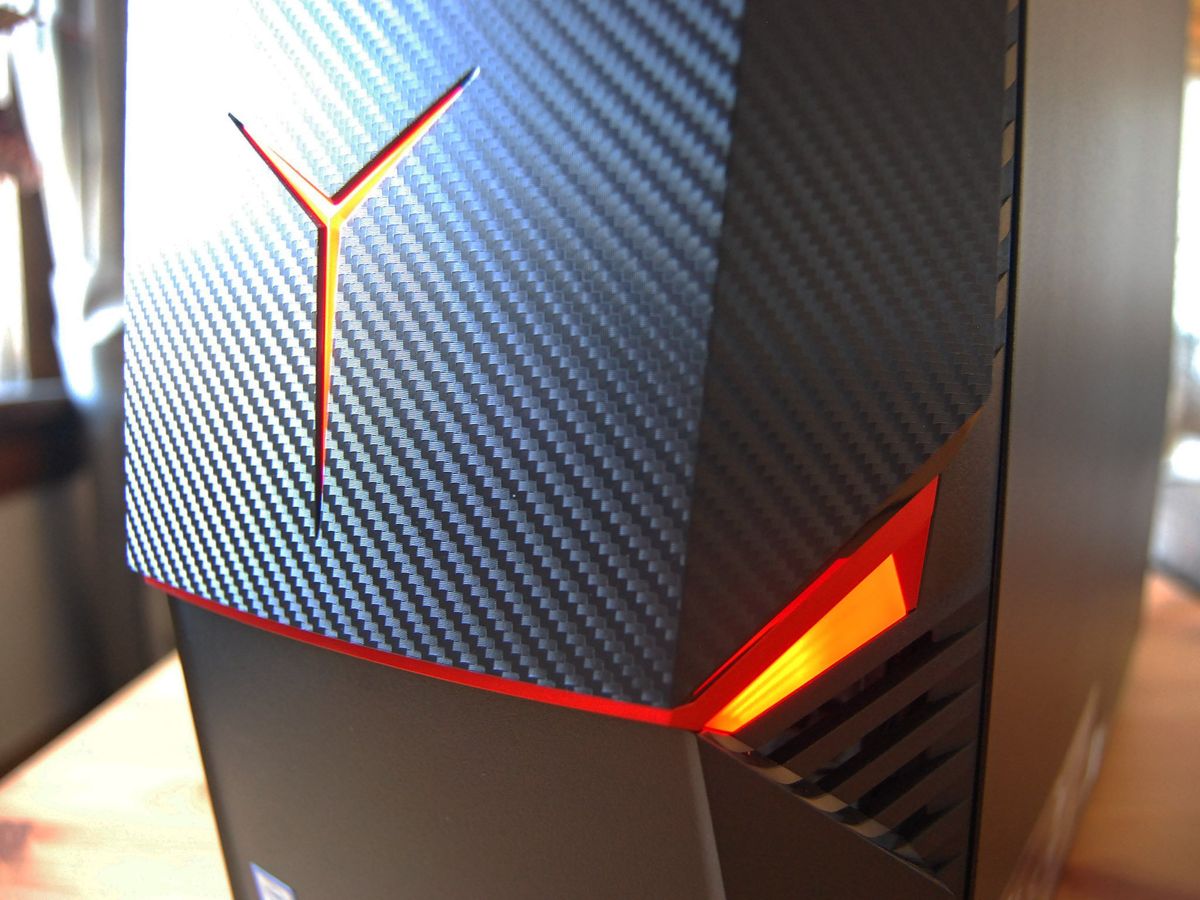Lenovo's Legion Y720 Tower (Y720T) gaming PC is a pre-built rig that's available in far less costly configurations than the high-end Y920T (which we also reviewed), but it also doesn't have quite as many features that gamers love. How does it compare to its siblings and other pre-built gaming PCs? Let's break things down.
About this review
Lenovo loaned Windows Central a review unit of the Legion Y720T. This specific configuration has a seventh-generation Intel Core i7-7700 processor (CPU), 16GB of DDR4 RAM, a 256GB solid-state drive (SSD) coupled with a 1TB hard-disk drive (HDD), and an NVIDIA GTX 1070 graphics card (GPU) with 8GB of GDDR5 VRAM. This specific configuration costs about $1,850.
Lenovo Legion Y720T hardware and specs
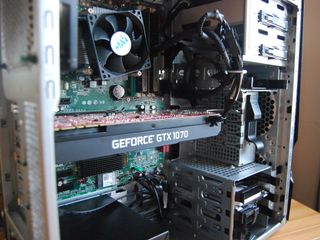
| Category | XX |
|---|---|
| Processor | Intel Core i7-7700 (3.60GHz) |
| RAM | 16GB DDR4-2400MHz |
| Storage | 1TB 7,200 RPM HDD256GB PCIe SSD |
| Graphics | NVIDIA GTX 1070 8GB |
| Motherboard | H270 chipset |
| Ports | Front:Two USB-A 3.0Two USB-A 2.0USB-CSD card reader3.5mm headphone jack3.5mm microphone jackRear:Two USB-A 3.0Four USB-A 2.0EthernetVGAPS/2DVIHDMI 2.0Three DisplayPort 1.4 |
| Wireless | Intel Dual Band Wireless 8265802.11ac (2 x 2)Bluetooth 4.1 |
| Keyboard | Included |
| Mouse | Included |
| Optical drive | DVD |
| Power supply | 450W |
| Weight | Starting at 31.08 pounds (14.1 kg) |
| Dimensions | 18.85 in x 19.82 in x 8.12 in(478.9 mm x 503.5 mm x 206.4 mm) |
| OS | Windows 10 Home |
Lenovo Legion Y720T design
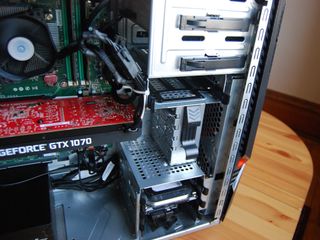
Lenovo's goal to allow for easy upgrades that we saw accomplished in the Y920T carries over to the Y720T. The chassis is essentially the same — albeit without a few of the finer features — with a side panel that comes off with a slide and push of a button. Inside there's plenty of room for extra or upgraded hardware, so you don't have to worry about obsolescence in a few years. Most things can be moved around or swapped out without the use of tools thanks to the heavy use of hand screws within.
The side panel here, however, doesn't have the clear cutout to show off the internal hardware, nor is there an internal LED. On the top, there is some chevron venting and a built-in handle, plus there is ample venting around the edges of the case for maximum airflow. The chassis is primarily black and has a carbon-fiber look on the front, and overall it's relatively subdued compared to some other gaming rigs on the market. The most eye-catching feature is the three-light combo on the front: two eyes and a Lenovo "Y" logo. The only LED customization options here are for brightness and on/off.


One of my favorite features on the Y920T is the port selection on the front of the PC. There you have HDMI, a few USB-A 3.0, and a USB-C port, perfect for quickly and easily hooking up a VR headset. Here, however, we're looking at a mix of USB-A 2.0 and 3.0, an SD card reader, and some audio jacks. These ports are fine for most people and the card reader is a bonus for any photographers, but for VR, the Y920T remains on top.
Lenovo Legion Y720T keyboard and mouse
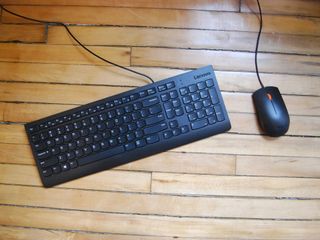
For accessories included with a gaming PC, the mouse and keyboard here are relatively plain. The wired keyboard is thin and light and not bad to type on, but it doesn't have some of the extra features gamers love. You're not getting a backlight, you're not getting mechanical switches, and there aren't any extra buttons to set up custom macro commands.
Likewise, the wired mouse has the standard two buttons and scroll wheel and not much else. It's ambidextrous, lightweight, and comfortable to use, but again it's more suited for an office than a gaming rig. The extra buttons, lights, and removable weights that often come with gaming mice are sorely missing, and anyone who's already used to a gaming mouse will leave this one in its box.
For accessories with productivity in mind these would cut it, and they will work as a starting point for your gaming PC. But you'll no doubt want to earmark a bit of extra cash for an upgrade in the near future if you don't already have gaming peripherals of your own.
Lenovo Legion Y720T gaming and VR
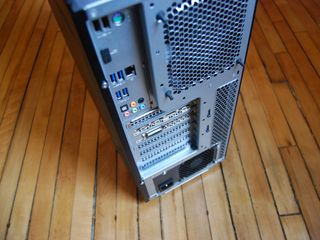
Despite not being Oculus certified, which allows access to thorough Oculus support, the Y720T handles VR without a hitch. Testing HTC Vive, Oculus Rift, and Windows Mixed Reality, we saw no problems. The GTX 1070 GPU has plenty of power, and it's backed up by the Core i7-7700 and 16GB of RAM.
If all you're looking for is a pre-built PC that can run modern games well, look no further. We ran some benchmarks to get an idea of performance before testing things out in a few real-world scenarios.
3DMark
Time Spy (Higher is better)
| PC | GPU | Score |
|---|---|---|
| Lenovo Legion Y720 Tower | GTX 1070 | 5,520 |
| Lenovo Legion Y920 Tower | GTX 1080 | 6,774 |
| Lenovo Legion Y720 | GTX 1060 | 3,469 |
| Lenovo Legion Y520 | GTX 1050 Ti | 2,491 |
| Razer Blade 2017 | GTX 1060 | 3,639 |
| Dell XPS 15 (9560) | GTX 1050 | 1,789 |
| Surface Book | GTX 965M | 1,531 |
| Spectre x360 | GT 940m | 613 |
Compared to the Y920T, the Y720T isn't far behind. It is, of course, also quite far ahead of even the Razer Blade gaming laptop.
3DMark
Fire Strike (Higher is better)
| PC | GPU | Score |
|---|---|---|
| Lenovo Legion Y720 Tower | GTX 1070 | 13,172 |
| Lenovo Legion Y920 Tower | GTX 1080 | 16,996 |
| Lenovo Legion Y720 | GTX 1060 | 9,017 |
| Lenovo Legion Y520 | GTX 1050 Ti | 6,623 |
| Razer Blade Pro | GTX 1080 | 12,976 |
| Dell XPS Tower SE | GTX 1070 | 12,315 |
| Razer Blade 2017 | GTX 1060 | 9,278 |
Considering 9,200 is an average rating for a VR PC, the Y720T scores quite well. The GTX 1070 isn't too far behind the GTX 1080 found in the Y920T.
VRMark
Orange Room (Higher is better)
| PC | GPU | Score |
|---|---|---|
| Lenovo Legion Y720T | GTX 1070 | 9,028 |
| Lenovo Legion Y920T | GTX 1080 | 10,688 |
For perspective, a premium high-end PC is expected to hit about 10,390. The Y720T scores well here and handles VR without issue.
For some real-world gaming examples, we tested Dying Light and PlayerUnknown's BattleGrounds (PUBG). We tested at 1440p, using mostly the highest graphics settings available from both options. The GTX 1070 GPU here didn't falter, offering up an average of 85.1 frames per second (FPS) in Dying Light and an average of 68.5 FPS in PUBG.
Lenovo Legion Y720T performance
If you're interested in purchasing a gaming rig to push the limits of your hardware, this isn't what you're looking for. The Intel CPU is lacking the "K" designation, meaning it isn't overclockable. Nevertheless, working with what you have is still going to deliver hefty performance, which you can see below.
CPU
Geekbench 4.0 Benchmarks (Higher is better)
| Device | CPU | Single core | Multi core |
|---|---|---|---|
| Lenovo Legion Y720 Tower | i7-7700 | 4,988 | 16,784 |
| Lenovo Legion Y920 Tower | i7-7700K | 5,484 | 18,438 |
| Lenovo Legion Y720 | i7-7700HQ | 4,697 | 14,810 |
| Lenovo Yoga 720 15 | i7-7700HQ | 3,784 | 10,255 |
| Surface Laptop | i5-7200U | 3,725 | 7,523 |
| Lenovo Legion Y520 | i7-7700HQ | 4,596 | 14,903 |
| Razer Blade 2017 | i7-7700HQ | 4,277 | 13,597 |
| Dell XPS 15 | i7-7700HQ | 4,503 | 13,587 |
| Razer Blade Pro | i7-6700HQ | 3,660 | 12,325 |
| Dell XPS 13 (9360) | i7-6560U | 4,120 | 7,829 |
| HP Spectre 13 | i7-7500U | 4,100 | 7,469 |
| Surface Book | i7-6600U | 3,948 | 7,415 |
Despite not being overclockable, the Core i7-7700 brings four cores to the table for a lot of multitasking power.
PCMark
PCMark Home Conventional 3.0
| Device | Score |
|---|---|
| Lenovo Legion Y720 Tower | 4,296 |
| Lenovo Legion Y920 Tower | 4,682 |
| Lenovo Legion Y720 | 3,599 |
| Lenovo Yoga 720 15 | 2,993 |
| Surface Pro 2017 | 3,055 |
| Surface Laptop | 2,494 |
| Lenovo Legion Y520 | 3,475 |
| Razer Blade 2017 | 3,448 |
| Dell XPS 15 | 3,534 |
The PCMark Home Conventional test takes a bunch of your hardware and determines how well it works together while performing a number of everyday tasks. As you can see, performance is way up there compared to laptops and even competes with the Y920T.
SSD
CrystalDiskMark (Higher is better)
| Device | Read | Write |
|---|---|---|
| Lenovo Legion Y720 Tower | 3,326.9 MB/s | 1,225.6 MB/s |
| Lenovo Legion Y920 Tower | 3,291.6 MB/s | 1,226.6 MB/s |
| Lenovo Legion Y720 | 1,642 MB/s | 789.7 MB/s |
| Lenovo Yoga 720 15 | 1,839 MB/s | 1,238 MB/s |
| Surface Laptop | 423 MB/s | 237 MB/s |
| Lenovo ThinkPad T470 | 1,079 MB/s | 716.1 MB/s |
| Lenovo Legion Y520 | 1,838 MB/s | 1,151 MB/s |
| Lenovo Yoga 720 | 1,904 MB/s | 1,169 MB/s |
| Lenovo X1 Carbon | 1,518 MB/s | 1,188 MB/s |
| Samsung Notebook 9 15 Ext | 1,365 MB/s | 1,213 MB/s |
| Razer Blade Pro | 2,571 MB/s | 2,467 MB/s |
| Dell XPS 15 (9560) | 2,207 MB/s | 1,628 MB/s |
| Dell XPS 13 (9360) | 1,287 MB/s | 794 MB/s |
| HP Spectre x360 15 | 1,128 MB/s | 862 MB/s |
The speeds posted above are straight from the Samsung PM961 SSD that is coupled with the Seagate 1TB HDD. These are great speeds, even for an SSD, but the HDD only hit a 201.5 MB/s read speed and a 197.4 write speed.
Lenovo Legion Y720T review: Conclusion
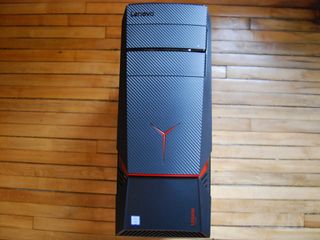
The mid-range option in a lineup of gaming PCs is usually positioned as a cheaper offering than the high-end model that nevertheless delivers a decent amount of power. To cut the cost, some features are usually removed. This is exactly what you have here. There are many Y720T configurations available, starting with the $900 baseline model with a Core i5-7400 CPU, 8GB of RAM, and a GTX 1050 Ti GPU.
The Y720T configuration reviewed here costs about $1,850, but oddly enough, you can get a Y920T with similar specs (differences being a K-series CPU and 1TB HDD/128GB SSD) for about $1,600. Don't forget that the Y920T comes with the upgraded gaming accessories, a different selection of front ports, customizable LED lights, and a clear cutout on the side.
So your decision is much easier to make, at least between the mid- and high-range Legion PCs. If you're not into overclocking, strobing LED lights, and don't mind GTX 1050 Ti, GTX 1060, or Radeon RX 570 GPUs, you can save a considerable amount of cash on the Y720T. When you get to the upper end, though, the Y920T becomes much more attractive and, in some cases, cheaper.
Pros:
- Plenty of configuration options.
- Low-cost entry level.
- Great performance output.
- Extra ports on the front for productivity.
Cons:
- Mouse and keyboard are not gaming-friendly.
- Upper end gets expensive.

Cale Hunt brings to Windows Central more than eight years of experience writing about laptops, PCs, accessories, games, and beyond. If it runs Windows or in some way complements the hardware, there’s a good chance he knows about it, has written about it, or is already busy testing it.
